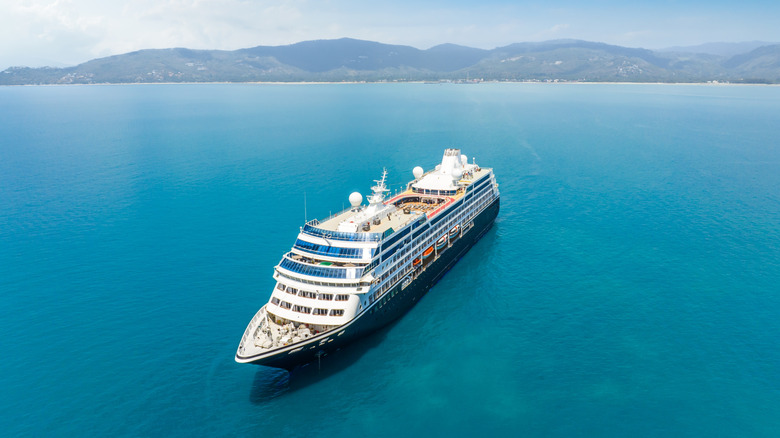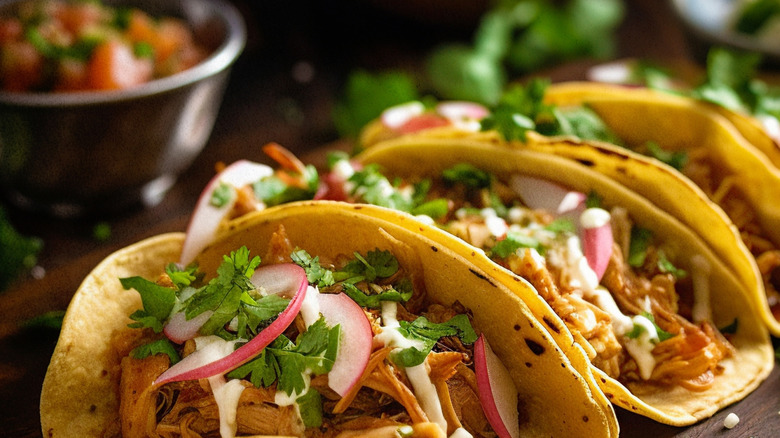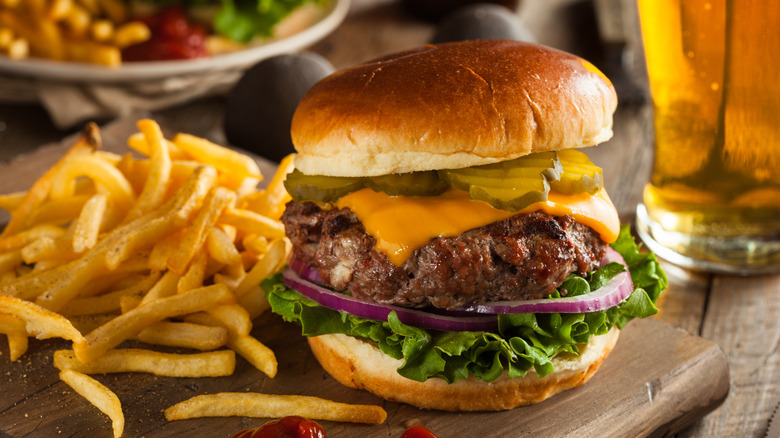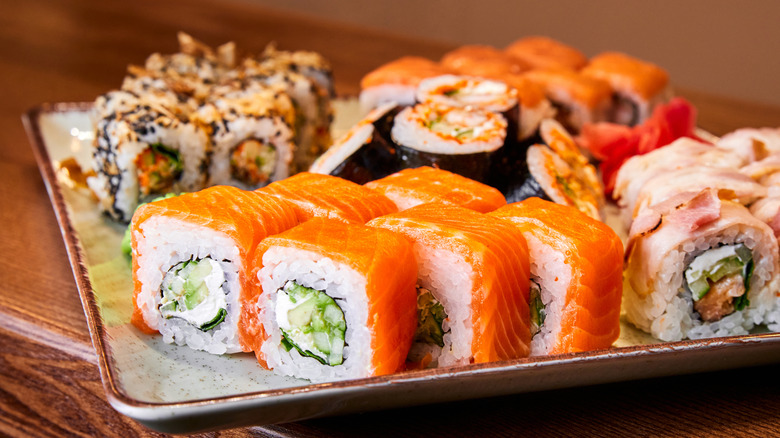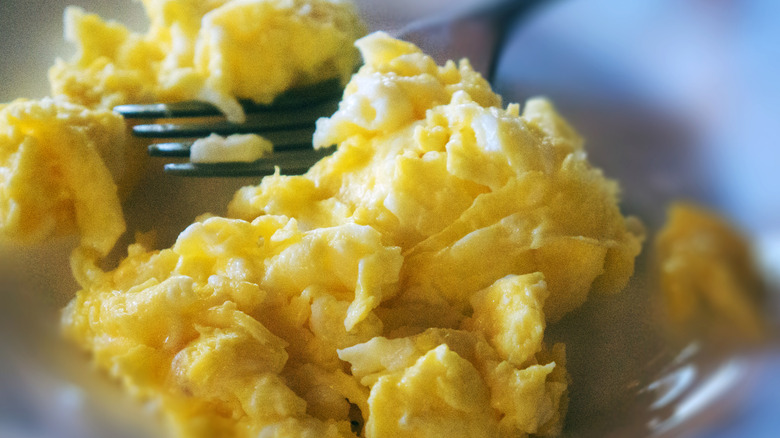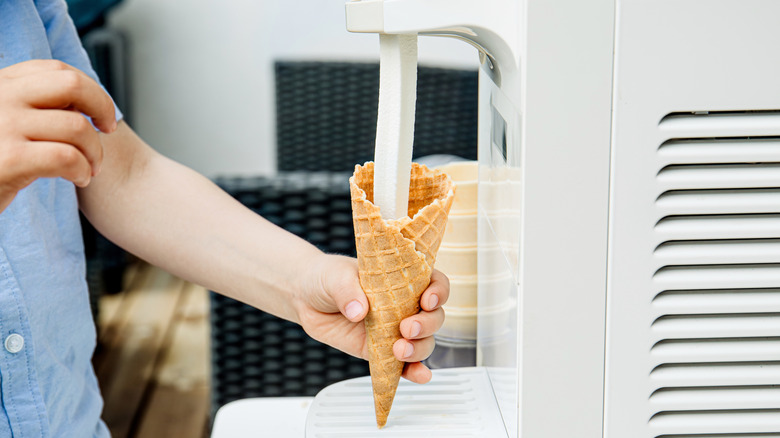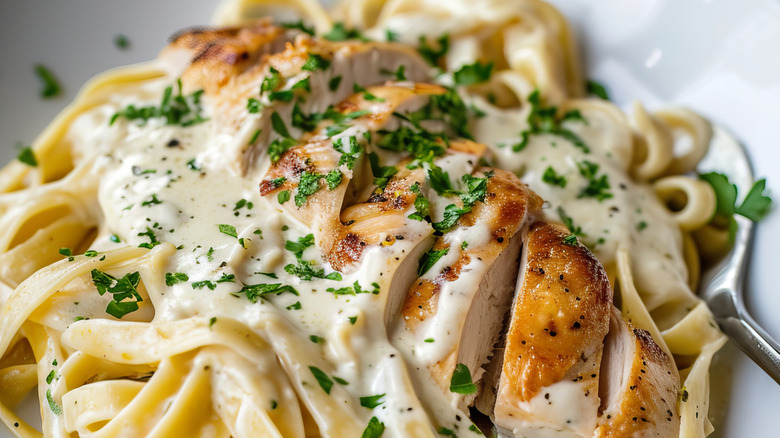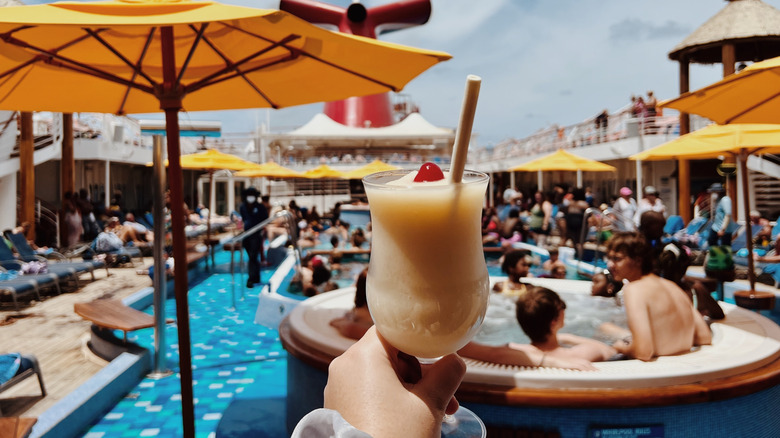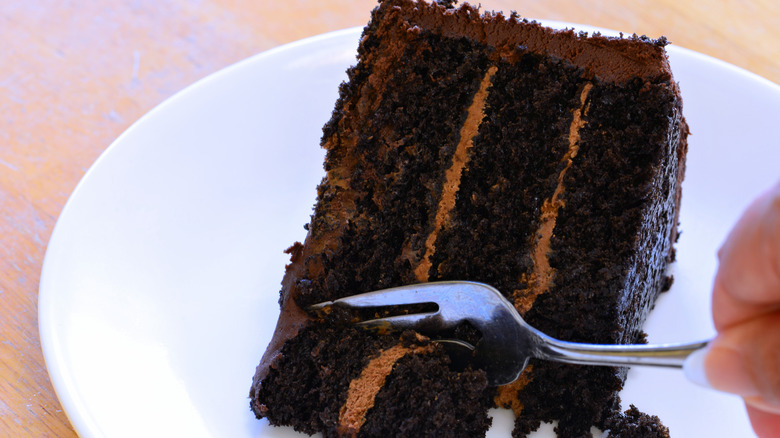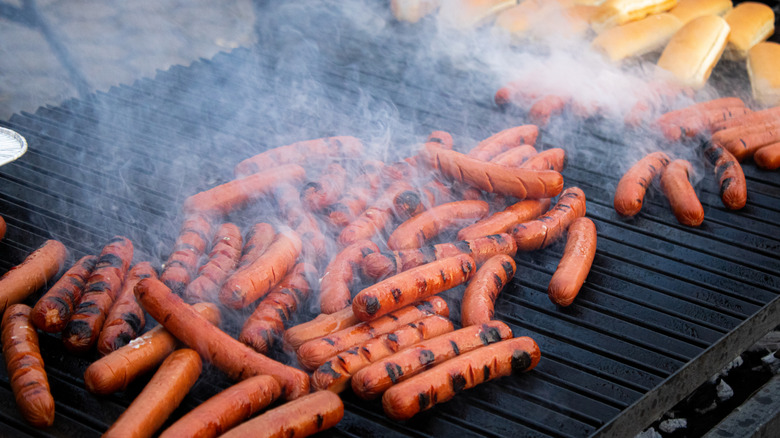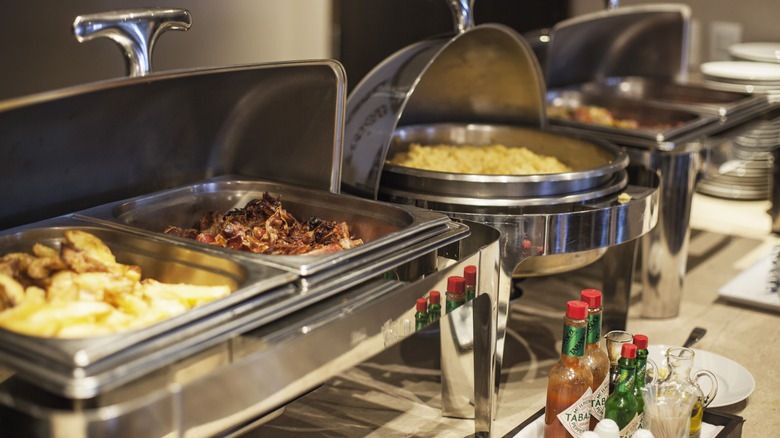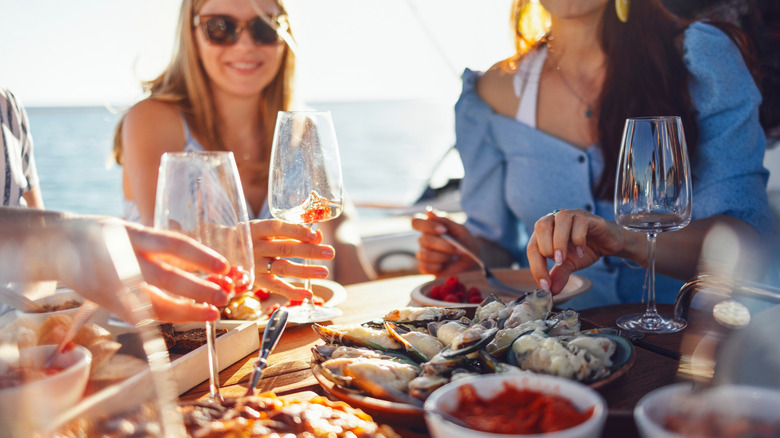11 Cruise Foods You're Better Off Avoiding If You Don't Have Your Sea Legs
Ahoy, foodie voyagers. So you've finally pulled the trigger on that bucket-list cruise adventure — the one with Instagram-worthy ocean sunsets, port calls, and the real reason we all book cruises: those legendary 24/7 all-you-can-eat buffets. There's just one teensy-weensy problem threatening your gastronomic paradise: Your stomach didn't get the "vacation mode" memo.
Cruise ships are where the food never stops coming, the dessert bar stretches into infinity, and the drinks flow like the ocean. For those with temperamental tummies, the massive ship can morph into a gut-churning house of horrors where each innocent wave seems to have a personal vendetta against your insides. Even the saltiest sea dogs — with thousands of nautical miles under their belts — can find themselves desperately gripping railings after a poorly timed encounter with the wrong buffet selection.
The good news? Not all cruise food will send you running for the railing or hiding in your stateroom with a box of motion sickness patches. By making strategic food choices, especially during those critical first 48 hours aboard, even the most sensitive stomachs can eventually adapt to life on the high seas. Fear not, queasy friends. This ultimate guide to navigating cruise cuisine with finicky sea legs will help you avoid food landmines and enjoy those overpriced shore excursions instead of viewing them through a green-tinted lens of nausea.
Spicy foods are the flame that rocks the boat
You're strutting into the main dining room, feeling fancy in your "formal night" attire, ready to conquer the menu. That fiery Thai curry or spicy chili is calling your name. Stop right there, adventure mouth. Spicy foods might satisfy your taste for excitement, but they'll wage war on your already confused tummy.
Spicy dishes ignite stomach acid production faster than your uncle posts political rants on Facebook. When your body's already playing a nauseating game of "find your balance" on the high seas, the last thing it needs is a five-alarm fire in your digestive tract. Capsaicin — the compound that brings the heat — irritates your stomach lining and can transform mild queasiness into full-blown seasickness faster than you can say, "Where's the bathroom?"
Save the hot sauce heroics for dry land. Instead, embrace milder flavors while sailing the seven seas. Your stomach (and cabin mates) will thank you for skipping the spice when the ship hits those first big waves. Trust the experts; nothing ruins the romantic moonlit deck stroll like making a mad dash for the nearest trash can.
Greasy and fatty foods
You hit the buffet and strike gold: fries so greasy they're glistening. Bacon curled up to perfection. And deep-fried whatever-the-heck-they-ares? Yum in one bite. That cheese pizza's just sitting there like it's been waiting for you specifically. But here's the deal — those fatty foods are like that friend who encourages terrible decisions at 2 a.m. They seem fun now, but when you're clutching the railing with the ocean tossing your stomach around like a washing machine? You'll be cursing that "innocent" plate of fries while everyone else is living it up at the pool party.
Greasy foods slow your digestion to a crawl. While the ship rocks and rolls, that heavy fat sits in your stomach like an unwelcome stowaway, taking its sweet time moving through your system. Your body — already working overtime to maintain balance in shifting conditions — must now divert resources to digest that triple bacon cheeseburger. It's like asking someone to solve complex math equations while riding a mechanical bull. Sounds challenging, right?
This results in a perfect storm of nausea, regret, and possibly an unpleasant reunion with your meal. Studies show that high-fat foods delay gastric emptying, which moves food from your stomach to your intestines and can significantly worsen motion sickness. Skip the grease and pick up a lighter meal that digests quickly, like that artfully displayed fruit.
Buffet sushi is a risky roll of the dice
You see that fancy sushi spread all laid out at the buffet and think, "Perfect! Something light that won't mess with my already iffy stomach." Big mistake. Grabbing buffet sushi when you're on a cruise is basically playing digestive Russian roulette. You're already teetering between "I'm totally fine" and "I need to find the nearest railing ASAP," and now you want to add questionable raw fish to the mix? Bold move, my friend. Bold move.
The raw truth: Sushi sitting on a buffet line for undetermined periods raises serious questions about freshness. Even with proper refrigeration (which isn't guaranteed), raw fish quality degrades quickly at room temperature. When that California roll has been sitting on the buffet line for who-knows-how-long, you're gambling with more than seasickness — you're risking food poisoning that could turn your dream vacation into a nightmare of biblical proportions.
If you're dying for a spider roll while aboard, see if your ship has a made-to-order sushi station where the chefs prepare on-demand rolls. These typically require an additional charge than the free buffet sushi, but that is for a reason. Made-to-order stations are more likely to maintain proper food safety standards. Even better, save your sushi adventures for port days at reputable restaurants. The combination of questionable raw fish and a rocking ship creates the perfect storm for an unpleasant experience that no amount of pickled ginger can remedy.
Scrambled eggs from the buffet
Those fluffy yellow mountains in the breakfast buffet steam trays look innocent enough. But buffet scrambled eggs harbor a dark secret that your queasy stomach will quickly discover. These mass-produced morning staples often come from powdered mixes or pasteurized liquid eggs that spend too much time under heat lamps, resulting in a rubbery, watery mess that even steady sea voyagers might struggle to digest.
The texture alone — sometimes dry as the Sahara, other times suspiciously watery — can trigger your gag reflex when you're already fighting to keep your equilibrium. Eggs are also high in sulfur compounds (hello, funky smell) and proteins that require significant digestive effort, so you've got a breakfast that might revisit you during that morning Pilates class on the Lido deck.
Instead, opt for made-to-order egg stations where a chef prepares fresh eggs to your specifications, or play it safer with easier-to-digest options like oatmeal, fresh fruit, or toast. If eggs are non-negotiable in your breakfast routine, try hard-boiled eggs, which are fresher and less processed than their scrambled counterparts.
Self-serve ice cream
That 24/7 self-serve ice cream machine — surrounded by grown adults with child-like glee in their eyes — might seem like the crowning achievement of cruise ship innovation. Free ice cream whenever you want it? What could go wrong? Plenty, if your stomach's already doing the cha-cha with every wave.
Beyond the questionable hygiene of a machine touched by hundreds of sticky hands daily (cruise outbreaks, anyone?), dairy can be particularly troublesome for motion-sensitive stomachs. The combination of high fat content, sugar, and cold temperature creates a triple threat that can overwhelm your digestive system.
Cold foods like ice cream cause blood vessels in your digestive tract to constrict, temporarily slowing digestion. Meanwhile, your body works harder to warm this frozen treat to body temperature, diverting energy it could be using to maintain your balance. The lactose and sugar further irritate your queasiness, leading to bloating and discomfort that can bother even seasoned passengers with iron stomachs.
If you cannot deny yourself that freebie soft-serve treat, time your chocolate vanilla swirl for when the seas are calmest, usually while docked at port. Better yet, reach for some fresh lemon sorbet or a fruit-based dessert from the buffet that eliminates dairy from the equation.
Creamy sauces and dishes
That mountain of pasta, chicken, and broccoli swimming in creamy Alfredo looks like it fell straight from the heavens. And would you just look at that lobster thermidor? The way that butter catches the light could make a grown adult weep — worth every damn penny you paid for your cruise fare. But before diving into these creamy concoctions, consider these rich, decadent sauces that might be plotting against your already-compromised equilibrium.
Creamy sauces are essentially fat bombs — loaded with butter, heavy cream, cheese, or some unholy combination of all three. These high-fat mixtures demand marathon-level digestive effort, forcing your body to produce extra enzymes and bile to break down all that richness. Meanwhile, your brain's already working overtime to manage the disconnect between what your eyes see (a stable dining room) and what your inner ear feels (the ocean's gentle — or not-so-gentle — swaying).
The result? It is a perfect storm of digestive distress that can transform a mild case of wobbles into full-blown seasickness. Even worse, these sauces tend to separate and break down under buffet heat lamps, becoming less appetizing by the minute. Nothing says "vacation regret" quite like watching congealed sauce remnants swirl down the bathroom drain while you're hanging over the toilet.
Opt for dishes with lighter, broth-based sauces or simple grilled options with a squeeze of lemon. You'll still enjoy delicious flavors without the digestive drama — and you might remember the evening entertainment instead of the inside of your cabin bathroom.
When booze makes you lose (your lunch)
That technicolor "Bahama Mama" or "Blue Hawaiian" practically screams "I'm on vacation" with its festive umbrella and fruit garnish overkill. But beneath that cheerful exterior lurks a motion sickness accelerant of epic proportions. Sugary cocktails deliver a one-two punch your queasy stomach simply doesn't need.
First, there's the sugar — often massive amounts hidden behind fruity flavors. Rapid sugar consumption can trigger blood sugar spikes followed by crashes, which may intensify feelings of fatigue and disorientation accompanying seasickness. Add in the dehydrating effects of both sugar and alcohol, and you've created the perfect environment for nausea to flourish like algae on a ship's hull.
Then there's the alcohol content — often multiple varieties in a glass. Many tropical cocktails contain two or three different spirits, multiplying alcohol's disorienting effects on your inner ear and balance centers. That rum floater seemed good until the ship hit its first significant wave.
If you're craving something special to sip, choose lower-sugar alternatives like club soda with lime, unsweetened iced tea, or even a simple glass of wine (in moderation). Better yet, make water your beverage of choice — staying hydrated is one of the best defenses against seasickness. Save the sugary concoctions for when you've found your sea legs or for that beachside bar during your shore excursion.
Heavy desserts
That chocolate lava cake with the perfect molten center beckons from the dessert menu. The cheesecake tower, architectural in its perfection, seems worth every calorie. But before you surrender to these sweet temptations, consider whether your stomach is as steady as your dessert desire.
Heavy desserts — particularly dense, rich options like cheesecake, flourless chocolate cake, or anything with "death" in its name — create a perfect storm in motion-sensitive digestive systems. These sugar and fat bombs require significant digestive effort, sitting in your stomach like concrete while your body struggles to process them. When the ship's motion already has your inner ear sending confused signals to your brain, you last need a digestive challenge of this magnitude.
The sugar content alone can spike blood sugar levels, potentially making you more sensitive to motion and exacerbating feelings of fatigue or lightheadedness. Combined with the hefty fat content that slows gastric emptying, you're left with the ideal conditions for that chocolate masterpiece to make a gross reappearance. If you simply can't resist dessert (you are on vacation, after all), consider lighter options like fruit sorbets, simple cookies, or just a few bites shared with dining companions. Save the more indulgent treats for port days when solid ground gives your stomach a fighting chance or for later in the cruise when you've developed those sea legs that let you truly enjoy all the culinary delights your floating resort offers.
Fast food options
With its never-ending supply of burgers, hot dogs, and fries, that poolside grill is the perfect casual lunch option. Nothing says "vacation mode" quite like munching on comfort food classics while lounging by the pool, right? Not so fast, queasy cruisers. These familiar favorites might be your stomach's worst enemies on the high seas.
Cruise ship fast food options typically come loaded with grease, fat, and sodium — a trio of troublemakers for motion-sensitive tummies. That mouthwatering burger contains meat with high-fat content, often cooked on greasy grills and topped with mayo or special sauce (more fat) and sandwiched between enriched white buns that offer minimal nutritional value but plenty of simple carbs that can spike blood sugar.
Those seemingly harmless fries chilling next to your burger? They're oil-thirsty traitors in disguise, guzzling grease like it's their last meal on earth. Your long-suffering stomach — already performing high-wire acts on the swaying ship — now faces an all-out battle with that greasy invasion. The brutal fallout? You'll transform into a foggy-brained zombie with heartburn erupting in your chest and tsunami-sized nausea that sends you retreating to your cabin in surrender while the smart cruisers are splashing, laughing, and living their best vacation lives poolside. Instead, look for grilled chicken, veggie burgers, or simple salads from the same grill stations. If you must indulge in cruise ship fast food, consider doing so when the seas are calmest or while docked at port.
Elaborate breakfast buffets
The breakfast buffet is a dream of many cruisers, stretching from one side of the boat to the other with an array of beautifully arranged favorites — Belgian waffles with syrupy lakes, mountains of bacon, pastries glistening with sugar, and croissant sandwiches loaded up with eggs. It's tempting to fill up your plate like a bear preparing for hibernation, but this early morning excess might sink your day faster than the Titanic (bad joke?).
Heavy breakfast feasts are particularly problematic for seasickness-prone cruisers. Your empty overnight stomach is especially vulnerable to motion sickness in the morning, and shocking it with a mix of heavy, fatty, and sugary foods creates perfect conditions for day-long queasiness. That enormous breakfast becomes even more problematic if you've scheduled morning activities or excursions where additional motion (like tender boats or bus rides) further challenges your equilibrium.
The combination of greasy breakfast meats, sugar-laden pastries, and carb-heavy options creates a digestive perfect storm. Your body diverts blood to your digestive system to manage this morning marathon, potentially making you more sensitive to the ship's motion when you should be enjoying those scenic port approaches or morning activities.
Instead, build a balanced breakfast plate with easy-to-digest options like fresh fruit, toast, oatmeal, or yogurt. These gentler choices provide sustained energy without overwhelming your sensitive system. Remember, you can always return for a mid-morning snack if you're truly hungry — the cruise ship food isn't going anywhere (except maybe up and down with the waves).
Finding your sea legs through smart food choices
Many seasick passengers see their condition improve within 48 hours as their bodies adapt to life at sea. This means your food restrictions likely won't last your entire vacation — just long enough to get those sea legs working properly.
While adapting, focus on motion sickness-friendly options that are abundant on every cruise ship. Fresh fruits, plain bread, clear broths, and ginger-containing foods can help settle your stomach rather than antagonize it. Many cruise lines now offer ginger tea at buffets specifically for passengers battling seasickness — take advantage of these thoughtful offerings.
Strategic eating can make a world of difference. Smaller, more frequent meals keep something in your stomach (which helps with nausea) without overwhelming your digestive system. Timing also matters — the smoothest sailing typically happens around midday or while docked, making these ideal times for more adventurous eating.
Some classic remedies that complement smart food choices are green apples, ginger candies, pressure bands, and over-the-counter medications that help bridge the gap until your body acclimates. Trade that queasy shade of green for Instagram-worthy glory. Make smart food choices and take your time, and you'll soon be the envy of your feed — posting drool-worthy buffet masterpieces instead of desperately hugging the railing as the horizon spins.
